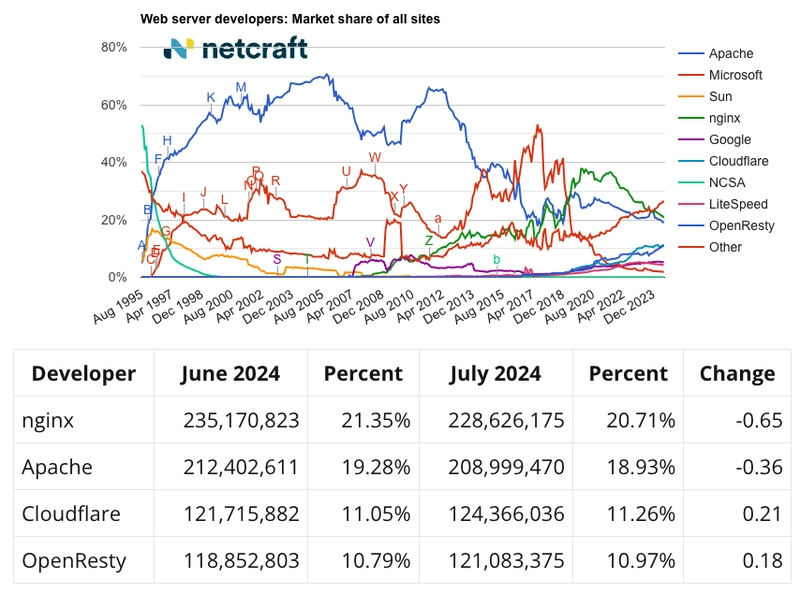Web Application Firewalls (WAFs) protect web applications by filtering, monitoring, and blocking malicious HTTP traffic. One of the most common deployment modes is reverse proxy, where the WAF acts as a gateway—intercepting traffic, inspecting it, and only forwarding safe requests to the backend servers.
SafeLine WAF adopts this reverse proxy architecture and relies heavily on Nginx to achieve high performance and flexibility. In this article, we’ll break down how Nginx works under the hood—and how SafeLine makes the most of it.
What Is Nginx?
Nginx is a lightweight, high-performance web server and reverse proxy. It handles massive traffic loads efficiently and is widely used for load balancing, content serving, and application gateway scenarios.
Key features of Nginx include:
- Multi-purpose proxy (HTTP, TCP/UDP, mail)
- Highly modular and event-driven design
- Native support for load balancing
- Extreme scalability with minimal resource consumption
Nginx powers a large portion of the internet and continues to lead in web server market share.
Why Is Nginx So Fast?
1. Master/Worker Process Model
Nginx separates control and execution:
- Master process manages configuration, handles signals, and spawns workers.
- Worker processes handle all actual requests. Each is single-threaded, typically bound to a CPU core for maximum efficiency.
This model allows seamless restarts, hot upgrades, and fault isolation. There’s no thread contention, no locking—just pure, streamlined performance.
2. Event-Driven Architecture
Unlike the traditional “one-thread-per-connection” model, Nginx uses asynchronous, non-blocking I/O with event loops.
It uses OS-level multiplexing mechanisms (e.g., epoll on Linux) to monitor thousands of connections without needing a thread for each one.
The result: massive concurrency and ultra-low latency, even under heavy load.
3. Modular Design
Everything in Nginx is a module—from HTTP processing to third-party features.
Nginx defines a consistent module interface (ngx_module_t) that developers can use to extend functionality. Modules are categorized:
- Core modules: Handle configuration and low-level logic.
-
HTTP modules: Built on
ngx_http_module, these manage web-specific logic like routing, compression, etc.
This modularity makes it easy to develop custom plugins—like SafeLine’s traffic inspection module.
4. More Engineering Highlights
- Written in C for total control over performance and memory usage.
- Implements its own data structures (e.g., hash tables, red-black trees) for speed.
- Uses memory pools for fast allocation.
- Offers powerful buffer handling with
ngx_buf_t. - Built-in support for advanced load balancing strategies.
How SafeLine Leverages Nginx
At the core of SafeLine WAF is a custom Nginx module called t1k, responsible for:
- Inspecting incoming HTTP requests
- Communicating with SafeLine’s detection engine
- Blocking malicious requests with a
403response - Letting clean requests continue to upstream servers
How It Works
- During the
accessphase of request processing, thet1kmodule generates a subrequest to a predefined internal route (@safeline). - This subrequest uses Nginx’s upstream mechanism to send request data to SafeLine’s backend for analysis.
- Based on the result:
- If the request is safe, it proceeds normally.
- If it’s malicious, Nginx returns a
403 Forbidden.
- SafeLine can also inspect response bodies using Nginx’s HTTP output filters.
Because Nginx is so flexible, this module can be embedded into standard Nginx deployments, or even into OpenResty-based API gateways like Kong or APISIX.
Final Thoughts
SafeLine’s use of Nginx is a great example of combining open-source infrastructure with advanced security logic. Nginx’s efficiency and extensibility make it the perfect foundation for building a high-performance, low-latency WAF.
Whether you’re building your own WAF modules or just want to understand how SafeLine works under the hood—Nginx is where performance and flexibility meet.
Join the SafeLine Community
If you continue to experience issues, feel free to contact SafeLine support for further assistance.






Top comments (2)
Free homework solutions: Just like SafeLine + Nginx boost web performance, our tools make studying faster and easier!visit the site for more help (homeworkifyofficial.us/)
Enhance digital protection efficiently with trucaller mod apk